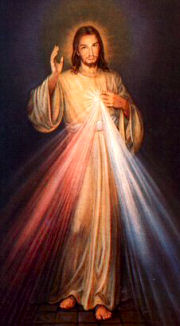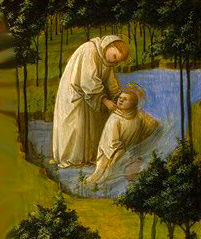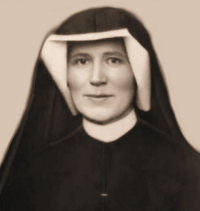Ordinary Time: October 5th
Monday of the Twenty-Seventh Week of Ordinary Time; St. Faustina Kowalska, virgin
Old Calendar: St. Placid and His Companions, martyrs
Newly canonized in 2000, some areas celebrate the Optional Memorial of St. Faustina Kowalska, a Polish nun who was chosen by Jesus to remind the world of the mystery of God's merciful love, the devotion to Divine Mercy.
According to the 1962 Missal of St. John XXIII the Extraordinary Form of the Roman Rite, today is the commemoration of St. Placid and His Companions. St. Placid was placed in the care of St. Benedict at Subiaco by his father when quite young. There had been a group of fourth-century Sicilian martyrs of whom one had the name Placid. This Placid was erroneously identified with the disciple of St. Benedict; thus arose the legend that the monk Placid, his sister, and thirty monks suffered martyrdom in the port of Messina at the hands of pirates.
St. Faustina Kowalska, Virgin
Saint Faustina was born in the 20th century, and canonized in the year 2000. Jesus chose her to deliver to the modern world a message as old as eternity. It is the message of his love for all people, especially sinners. Jesus said to Faustina, "Today I am sending you with my mercy to the people of the whole world." It is his desire to heal the aching world, to draw all people into his merciful heart of love.
On February 22, 1931, Jesus appeared to Faustina as the King of Divine Mercy. He asked her to have a picture painted of him as she saw him — clothed in white, with red and white rays of light streaming from his heart. The rays represent the blood and water that flowed from the side of Jesus on the cross. Under the image are the words, "Jesus, I trust in you."
Many people did not believe Faustina at first. The sisters in her own convent thought that Jesus could not possibly have selected her for this great favor. After all, she was an uneducated peasant girl. Her superiors often refused to give her permission to carry out Jesus' requests. Church theologians, too, doubted her word. Jesus told Faustina that he loved her obedience and that his will would be done in the end.
 In June 1934 an artist completed the painting of the Divine Mercy according to her instructions; and it soon became a focus for devotion. Faustina continued to record in her diary the appearances of Jesus. The diary was translated into English and published in 1987 with the title Divine Mercy in My Soul.
In June 1934 an artist completed the painting of the Divine Mercy according to her instructions; and it soon became a focus for devotion. Faustina continued to record in her diary the appearances of Jesus. The diary was translated into English and published in 1987 with the title Divine Mercy in My Soul.
Faustina, baptized Helena, had grown up in a poor Polish family of 10 children. When she was 15 years old, she quit school in order to work as a housemaid to help support her family. By the time she was 18, she was sure that God was calling her to a religious life, but her parents objected. So she tried to put it out of her mind. But one night, while the lively polka music was playing at a village dance, Helena saw Jesus, sad and suffering. The very next day she packed a small bag and went to the capital city of Warsaw to join the Sisters of Our Lady of Mercy. There she received the name Sister Mary Faustina.
About 10 years later, Faustina contracted tuberculosis. Soon she was too weak to manage the heavy gardening assigned to her. So she was given the job of gatekeeper. She was able to show mercy to the poor people who came to the convent looking for food. Once Jesus came to the door as a poor young man. After he had eaten the soup and bread Faustina gave him, she recognized him. Jesus told her he had come to experience with great joy her tender love and mercy.
Faustina was canonized by the first Polish pope, John Paul II, on April 30, 2000. The first Sunday after Easter was declared Divine Mercy Sunday.
Excerpted from Saints and Feast Days: A Resource and Activity Book by The Sisters of Notre Dame of Chardon, Ohio.
Symbols: young nun in habit; nun with vision of Jesus, with two streams of light, one red and white (Divine Mercy image).
Things to Do:
- Read a short biography of Sr. Mary Faustina Kowalska from the Vatican.
- Read the Holy Father's April 30, 2000 Homily at the solemn Mass celebrated for the canonization of Sr. Mary Faustina Kowalska.
- From the Directory on Popular Piety and Liturgy: Devotion to the Divine Mercy
In connection with the octave of Easter, recent years have witnessed the development and diffusion of a special devotion to the Divine Mercy based on the writings of Sr. Faustina Kowalska who was canonized 30 April 2000. It concentrates on the mercy poured forth in Christ's death and resurrection, fount of the Holy Spirit who forgives sins and restores joy at having been redeemed. Since the liturgy of the Second Sunday of Easter or Divine Mercy Sunday — as it is now called — is the natural locus in which to express man's acceptance of the Redeemer's mercy, the faithful should be taught to understand this devotion in the light of the liturgical celebrations of these Easter days. Indeed, "the paschal Christ is the definitive incarnation of mercy, his living sign which is both historico-salvific and eschatological. At the same time, the Easter liturgy places the words of the psalm on our lips: "I shall sing forever of the Lord's mercy" (Ps 89[88]: 2).
- Read more from our Catholic Culture library about the Divine Mercy devotion, in particular, a short description of The Divine Mercy devotion
- St. Faustina came from Poland. John Paul II was also Polish, and had a great devotion to the Divine Mercy. He made it a feast day on the second Sunday after Easter. Find out more about Poland and its customs. It's a very Catholic country, with deep devotion to Our Lady. A wonderful book that gives a wonderful understanding of the culture is the Pope's biography A Witness to Hope by George Wiegel. This site contains many Polish Traditions. The Polish Art Center has many resources for Polish customs.
- Try your hand at a Polish dish or two. Perhaps practice making some of the favorite foods for the Polish Wigilia (Christmas Eve Dinner) Pierogi (or Pirohi) is one of the most popular Polish foods, but do some research to find other recipes.
St. Placid and His Companions St. Placid was born in Rome, in the year 515, of a patrician family. When he was seven years old he was brought to St. Benedict by his father, to be trained in monastic life. He became the most illustrious member in the circle of Benedict's first followers. Alongside the awe-inspiring figure of the holy patriarch stands little Placid, and with the innocent simplicity of a child he does much to soften the austerity emanating from the patriarch of monks. Pope St. Gregory devotes several chapters to Placid in his second book of Dialogues. "Once while blessed Benedict was in his room, one of his monks, the boy Placid, went down to get some water. In letting the bucket fill too rapidly, he lost his balance and was pulled into the lake, where the current quickly seized him and carried him about a stone's throw from the shore. Though inside the monastery at the time, the man of God was instantly aware of what had happened and called out to Maurus: 'Hurry, Brother Maurus! The boy who just went down for water has fallen into the lake, and the current is carrying him away.'
St. Placid was born in Rome, in the year 515, of a patrician family. When he was seven years old he was brought to St. Benedict by his father, to be trained in monastic life. He became the most illustrious member in the circle of Benedict's first followers. Alongside the awe-inspiring figure of the holy patriarch stands little Placid, and with the innocent simplicity of a child he does much to soften the austerity emanating from the patriarch of monks. Pope St. Gregory devotes several chapters to Placid in his second book of Dialogues. "Once while blessed Benedict was in his room, one of his monks, the boy Placid, went down to get some water. In letting the bucket fill too rapidly, he lost his balance and was pulled into the lake, where the current quickly seized him and carried him about a stone's throw from the shore. Though inside the monastery at the time, the man of God was instantly aware of what had happened and called out to Maurus: 'Hurry, Brother Maurus! The boy who just went down for water has fallen into the lake, and the current is carrying him away.'
"What followed was remarkable indeed, and unheard of since the time of Peter the apostle! Maurus asked for the blessing and on receiving it hurried out to fulfill his abbot's command. He kept on running even over the water till he reached the place where Placid was drifting along helplessly. Pulling him up by the hair, Maurus rushed back to shore, still under the impression that he was on dry land. It was only when he set foot on the ground that he came to himself and looking back realized that he had been running on the surface of the water. Overcome with fear and amazement at a deed he would never have thought possible, he returned to his abbot and told him what had taken place.
"The holy man would not take any personal credit for the deed but attributed it to the obedience of his disciple. Maurus on the contrary claimed that it was due entirely to his abbot's command. He could not have been responsible for the miracle himself, he said, since he had not even known he was performing it. While they were carrying on this friendly contest of humility, the question was settled by the boy who had been rescued. 'When I was being drawn out of the water,' he told them, 'I saw the abbot's cloak over my head; he is the one I thought was bringing me to shore.'" (From The Life and Miracles of St. Benedict by Pope Gregory the Great, translated by Odo Zimmermann, O.S.B. and Benedict Avery, O.S.B.)
—Excerpted from The Church's Year of Grace, Pius Parsch.
Symbols: Tongue and knife; crescent; sword.
